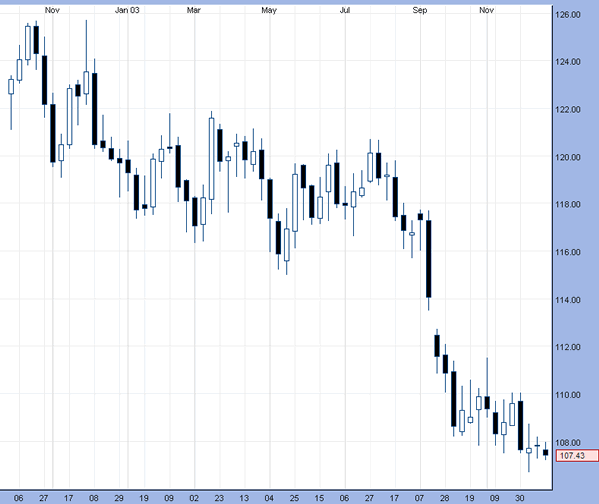The seminars and training courses I have taught in the past have involved the use of technical analysis to determine when to buy and sell a given currency pair. Currencies can be studied using technical analysis just like stocks and any other asset class.
When a stock trader with no knowledge of the currency market looks at at a chart of the US Dollar versus the Japanese Yen, he might actually think that he is looking at the price of a stock. “Is this the chart of IBM?,” he might ask himself. This is because a currency looks the same on a chart than a stock. Look at the charting example below of the USD/JPY (each bar represents one week of prices):
The candlestick chart above represents about 1 year of exchange rate data. It shows the dollar getting weaker against the yen throughout the entire period in question. Many times, if you look at a year’s worth of data for any currency, it will establish the same steady trend in one direction (look at the above example). This is because some fundamental factors that affect the prices of currencies can be in effect for months or years. Thus, foreign currencies tend to trend better than stocks and the trends typically last longer. This is also true for intermediate trends that exist within the longer-term trend, a characteristic that many who plan to take up currency trading like.
Many traders [including myself] feel that currencies tend to respond better to technical analysis than stocks and the moves tend to be more continuous. Part of the reason for this is that since the forex market is more liquid than the stock market [based on many estimates], currencies are a lot more difficult to manipulate. In the stock market, it is easy for a day trader to be forced to exit a position by a buyer or seller of size, even if the trader entered the position according to logical technical reasons based on his methodology. This becomes obvious when we look at an example. The most liquid stocks like Microsoft (MSFT) or Apple (AAPL) easily trade from 30 to 100 million shares a day. This is about 1.5 to 10 Billion dollars in value (based on 2014 estimates). In comparison, the daily volume range of the forex market is in the trillions of dollars, divided mainly among the top four or five major currencies. It is thus a lot easier to manipulate the price of MSFT at any given point in time during the day than it is to move the EUR/USD. When we deal with other popular stocks that have a lower daily volume than AAPL and MSFT, manipulation becomes even easier.
Remember the horror stories from 2000 to 2003 of the corrupt Wall Street analysts touting the stocks that their firms were selling? Now imagine the same scenario with currencies. What would the price chart of the euro have done if the same Wall Street analysts recommended that their clients buy euros when they themselves were selling? Even if this fiasco would have been brought to light, NOTHING! The euro would have shrugged off the whole thing.
Back: Order Types | Next: Fundamental Analysis


